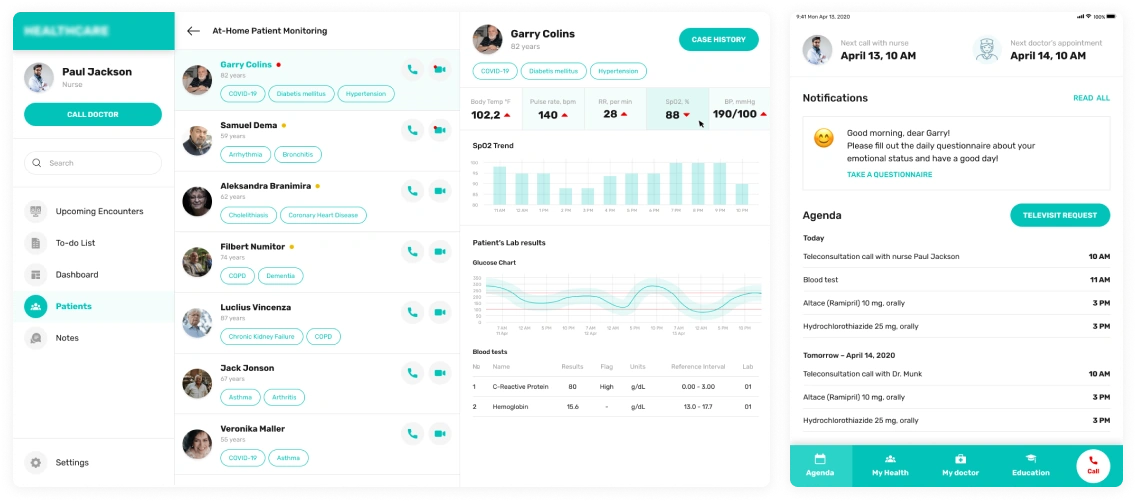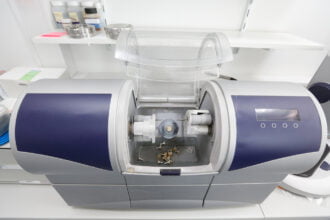Technology provides healthcare organizations with many benefits. Clinics save money, organize internal processes more efficiently, and serve patients better. But not all medical institutions are ready to embrace innovation. They question the suitability of technology and don’t know how to switch to a new format of work. They consider innovations as additional costs which are hard to justify. You should plan healthcare software development reasonably – and then all such changes will pay off. In this article, we’ll share five ways to reduce the cost of a medical project.
Ways to reduce the cost of a healthcare software solution
If a healthcare executive or business owner is looking for a financially reasonable way to develop healthcare software, there are five ways to go.
Medical application development outsourcing
Each medical institution has its own workflow, a team of doctors, and ways of interacting with patients. Not every healthcare facility is suitable for ready-made software solutions available on the market. Therefore, clinics and hospitals are striving to create digital products adapted to their needs. They have two options:
- they can hire developers who will implement a project;
- or seek outsourcing assistance.
The first path is more difficult and expensive. The manager of a clinic or hospital has to spend time and money looking for specialists. It is necessary to arrange workplaces, purchase the needed equipment, and devote time to introducing new employees to the project. You will also have to pay developers a monthly salary including taxes and utility bills.
The second way means hiring employees of a third-party IT company. The customer is looking for a favorable price-quality ratio on the market. They study the websites of foreign IT companies, compare their pricing policies, and explore candidates’ capacities (portfolio of projects, technical stack, and a team of specialists). It is necessary to contact company managers and discuss the upcoming project. For businesses, this approach is beneficial, because:
- A company gets a ready-made team with the necessary skills and experience. No need to independently search and select candidates, which may take up to two months. An outsourcing company selects a team and starts developing a project within two weeks.
- The manager does not need to rent a room for new employees and purchase equipment. The outsourcing company has the necessary working environment, software, and hardware. The customer only pays for the work of engineers, they are not responsible for utilities and other issues.
- The salary of outsourcing employees can be lower than that of full-time specialists. If the customer company is based in America, it is guided by the average salary in the US. Abroad, the hourly rate of developers can be twice as low. But in some cases, the price is comparable to the quality of development, so it’s also not worth the risk for the sake of savings. It is better to strike a balance between software development cost and quality by comparing several IT outsourcing companies.
Running medical applications in the cloud
Before starting a healthcare software development project, the customer should determine the type of server on which the application will run. A computer takes up space in the office and the company needs to maintain its work. A cloud data center is much more convenient as the cloud service provider takes care of backend issues.
The second option is not only convenient but also profitable. A clinic or hospital does not need to have a separate room for servers, purchase equipment, maintain it, and pay for electricity. The cloud provider takes care of these issues, offering the customer the necessary computing power. It issues invoices for use. As the application develops and scales, the cloud supports high traffic. Thus, healthcare organizations receive not only savings but also the necessary flexibility.
Regular communication with the development team
Developers divide bugs into two categories: technical errors and errors of “misunderstanding”. The first ones depend on the tech stack and the experience of IT professionals working on a healthcare project. The second group is related to how the development team and the customer understand each other. When a development company does not fully understand the client, it implements the wrong functionality. As a result, you have to redo the work, which means a loss of time and money for your business.
To prevent this, the customer can secure themselves in the following ways:
- they should not start a project until it is clear what they want from custom healthcare software;
- hire professionals with experience in developing medical projects;
- let a Business Analyst from the IT partner company collect the requirements for the product and prepare the specification. The document will resolve misunderstandings and secure against mistakes;
- hold regular meetings to discuss the progress of the project and completed tasks.
These measures will remove misunderstandings between the development team and the customer. The team will include the correct features in the application without having to redesign the program.
Inclusion of only relevant functions in the application
You can save money by building your application using the lean software development method. In this case, functionality is carefully thought out and only important features that are relevant to users are implemented in the software. How to check it? Create a minimum viable product (MVP).
MVP is the basic version of a software product, which includes functions critical for the operation of the application. With such functionality, the program can be released to the market and “tested”. Users (patients, doctors, hospital administrators, and accountants) work with the product and leave feedback. They express their wishes to the development team and participate in various surveys.
The team finds out what the target audience is missing and develops the application according to their needs. Thus, developers do not waste time and project budget implementing unnecessary functions.
Using Agile Development Methodology
If the client company does not know exactly what functions the medical application should include, it is worth using Agile or other flexible methodologies. Agile gives the team the flexibility to:
- quickly respond to changes in software requirements;
- complete the development even if the budget is reduced;
- make fewer errors in the program due to regular communication with the customer;
- conduct continuous testing and deliver the application to the market;
- track user feedback and adapt the product to the company’s needs.
What does flexibility mean for a business? McKinsey & Company calculated that agile practices reduce time to market by 40%. The Standish Group claims that agile projects are 4 times more successful than classical ones and cost 3.6 times less.
Business benefits of custom healthcare software development
Why develop a medical application from scratch when cheaper commercial programs are available on the market? But such savings are not always justified. Ready-made solutions may not suit the clinic and contain unnecessary functionality.
Custom healthcare software has five advantages:
1. It includes only the features users need.
When ordering healthcare software development, businesses pay only for what they really need. A custom application solves specific business problems or takes into account relevant user needs, making a digital service convenient and personalized.
2. It saves money in the long run.
The initial price of a ready-made solution is lower than the cost of individual software. But this advantage is temporary. A clinic will have to pay a regular subscription fee and renew the seat license to use a commercial application. After several years of use, a significant amount will come out, it will be comparable to investments in healthcare software development.
In individual development, the situation is different. At the start of your project, you need to invest a large amount of money to create an application, so that you can use it for free later. Only regular system updates are required.
3. It is easy to maintain and support.
The provider of the healthcare application guarantees that it will maintain and update the product within a certain time. But if the provider decides to terminate the service or goes bankrupt, the customer will have to solve problems on their own and hire a support engineer or migrate to new software.
When a clinic or hospital works with a custom medical application, it controls and maintains the product itself or with the help of its technology partner.
4. It is easy to scale.
Sometimes, you cannot scale off-the-shelf medical applications on demand. Therefore, if the manager knows that the business will grow, an easily scalable solution is needed. Custom healthcare software is suitable for a rapidly growing business. Developers can enable this feature in the system so that the application does not break under heavy load and can easily collect growing amounts of data.
5. It provides better cyber security.
No medical application (both off-the-shelf and custom) can be 100% secure. Hackers “probe” programs for vulnerabilities in order to steal the personal data of users. Commercial applications are the first target in this regard. They contain the confidential data of clients of all institutions that have bought a ready-made program. Hackers attack custom software mainly if they target a specific firm.
Three examples of cost-effectiveness of custom healthcare software
How profitable is the investment in a custom healthcare application? Many factors affect ROI: the specifics of the organization’s work, the degree of digitalization, the funds invested in development, and other parameters. Here are some successful projects that started to pay off in the first months after launch.
Electronic health record development project
An American home care company wanted to create an EHR that would link branches of the organization and improve patient care. The platform was supposed to integrate with IoT sensors to collect information about the health of the elderly.

The company’s IT partner implemented the required functionality. The development team set up telemedicine communication, connection to IoT devices, and monitoring of medication intake. Specialists integrated the application with PMS and RCM systems and an inventory management platform.
6 months after the implementation of the system, the customer increased revenue by 11%. The number of hospitalizations of patients decreased by 20% due to improved remote monitoring.
Telecare platform
A Canadian company needed a doctor appointment application and applied for outsourced software development. In the application, the IT partner helped to implement telemedicine functions, AI-based patient triage, and medical image processing. The scheduler also included an automatic setting of reminders, a speech-to-text recognition function, an electronic prescription module, and invoice processing.

The Canadian market warmly welcomed the new software solution: 95% of users are satisfied with Telecare. The company’s revenue grew by 30% within six months after the release of the program.
Application for checking tests for COVID-19
The team created an application that collects raw results from laboratories. An artificial intelligence algorithm analyzes them, places them on a dashboard, and generates a report. Thus, all the doctor needs to do is check and confirm the data.

The platform accelerated the processing of analyses up to 96 tests per minute. The lab increased productivity without sacrificing quality.
Conclusion
Results and ROI can be even better if custom healthcare software meets the needs of a medical organization as precisely as possible. When the customer has clearly defined requirements, and the IT partner plans the stages of work on the product, then it is possible to secure the project from errors and unexpected costs. You can create a quality product with minimal investment and losses. Therefore, it is important to find an experienced technology partner to build a successful healthcare software development project.









